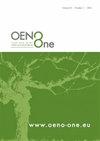The impact of dosage sugar-type and aging on Maillard reaction-associated products in traditional method sparkling wines
IF 2.2
3区 农林科学
Q3 FOOD SCIENCE & TECHNOLOGY
引用次数: 2
Abstract
Liqueur d’expedition (dosage) is a final sugar addition made to sparkling wine which determines the sweetness and balance of the finished product. In the present study, the influence of dosage sugar composition on Maillard reaction-associated products and precursors in traditional method (bottle-fermented) sparkling wines was evaluated over 18-months of storage in climate-controlled cellar conditions (14 °C, 70 % relative humidity). Evaluated dosage sugar-types included glucose, fructose, cane-derived sucrose, beet-derived sucrose, maltose, and Must Concentrate Rectified (MCR) Sucraisin®, which were compared to a zero dosage (no sugar added) control. Maillard reaction-associated products were quantified by headspace solid-phase microextraction coupled to gas-chromatography-mass spectrometry (HS-SPME-GC/MS), and precursors including sugars and amino acids, were measured by enzymatic assay and proton (1H) nuclear magnetic resonance (NMR) spectroscopy, respectively. Partial least squares discriminant analysis (PLS-DA) was used to effectively discriminate between wines based on aging duration but did not adequately separate wines treated with different dosage sugar-types. Decreases in alanine and glycine were observed after 18-months of cellar aging, suggesting that Maillard reaction product formation may be partially related to their depletion. Benzaldehyde and ethyl-3-mercaptopropionate were identified as discriminatory Maillard reaction-associated compounds when comparing 0- and 18-month aged wines, with benzaldehyde increasing and ethyl-3-mercaptopropionate decreasing over the aging period. This research contributes to an increased understanding of Maillard reaction pathways in the unique low-temperature and low pH sparkling wine matrix and establishes the relatively greater effect of aging duration compared to dosage sugar-type on the formation of Maillard reaction-associated products. The combined application of HS-SPME-GC/MS and 1H NMR based metabolomics presents new insights into the chemical composition of sparkling wines during aging.用量、糖型及陈酿对传统起泡酒美拉德反应产物的影响
利口酒(用量)是起泡酒中最后添加的糖,它决定了成品的甜度和平衡。在本研究中,在气候控制的酒窖条件下(14°C, 70%相对湿度)储存18个月,评估了用量糖组成对传统方法(瓶装发酵)起泡酒中美拉德反应相关产物和前体的影响。评估的剂量糖类型包括葡萄糖、果糖、甘蔗衍生蔗糖、甜菜衍生蔗糖、麦芽糖和必须浓缩精馏(MCR)蔗糖素®,与零剂量(不添加糖)对照进行比较。美拉德反应相关产物采用顶空固相微萃取和气相色谱-质谱联用(HS-SPME-GC/MS)定量,前体包括糖和氨基酸分别采用酶法和质子(1H)核磁共振(NMR)光谱测定。采用偏最小二乘判别分析(PLS-DA)对不同陈酿时间的葡萄酒进行了有效的区分,但不能充分区分不同糖型用量的葡萄酒。窖藏18个月后发现丙氨酸和甘氨酸的减少,表明美拉德反应产物的形成可能与它们的消耗部分相关。在比较0个月和18个月陈酿的葡萄酒时,苯甲醛和3-巯基丙酸乙酯被鉴定为具有区别性的美拉德反应相关化合物,随着陈酿时间的推移,苯甲醛含量增加,3-巯基丙酸乙酯含量减少。本研究有助于加深对独特的低温低pH起泡酒基质中美拉德反应途径的理解,并确立了陈化时间对美拉德反应相关产物形成的影响相对于糖型用量更大。基于HS-SPME-GC/MS和1H NMR的代谢组学的结合应用为起泡酒在陈酿过程中的化学成分提供了新的见解。
本文章由计算机程序翻译,如有差异,请以英文原文为准。
求助全文
约1分钟内获得全文
求助全文
来源期刊

OENO One
Agricultural and Biological Sciences-Food Science
CiteScore
4.40
自引率
13.80%
发文量
85
审稿时长
13 weeks
期刊介绍:
OENO One is a peer-reviewed journal that publishes original research, reviews, mini-reviews, short communications, perspectives and spotlights in the areas of viticulture, grapevine physiology, genomics and genetics, oenology, winemaking technology and processes, wine chemistry and quality, analytical chemistry, microbiology, sensory and consumer sciences, safety and health. OENO One belongs to the International Viticulture and Enology Society - IVES, an academic association dedicated to viticulture and enology.
 求助内容:
求助内容: 应助结果提醒方式:
应助结果提醒方式:


